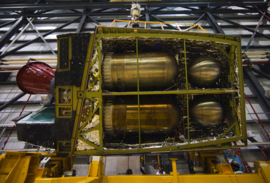
Summary
The Orbital Maneuvering System (OMS) is a system of hypergolic liquid-propellant rocket engines used on the Space Shuttle and the Orion MPCV. Designed and manufactured in the United States by Aerojet,[1] the system allowed the orbiter to perform various orbital maneuvers according to requirements of each mission profile: orbital injection after main engine cutoff, orbital corrections during flight, and the final deorbit burn for reentry.[2] From STS-90 onwards the OMS were typically ignited part-way into the Shuttle's ascent for a few minutes to aid acceleration to orbital insertion. Notable exceptions were particularly high-altitude missions such as those supporting the Hubble Space Telescope (STS-31) or those with unusually heavy payloads such as Chandra (STS-93). An OMS dump burn also occurred on STS-51-F, as part of the Abort to Orbit procedure.[3]
 The underside of a left OMS/RCS pod on Space Shuttle Endeavour | |
| Manufacturer | Aerojet |
|---|---|
| Country of origin | United States |
| Used on | Space Shuttle/Orion European Service Module |
| General characteristics | |
| Length | 21.8 feet (6.6 m) |
| Width |
|
| Launch history | |
| Status | Pod Retired/Engines Active |
| Total launches | 135 Space Shuttle/ 1 Orion |
| Successes (stage only) | 134 Space Shuttle/ 1 Orion |
| Lower stage failed | 1 (STS-51-L) |
| First flight | STS-1 (12 April 1981) |
| Last flight | |
| OMS Engine | |
| Powered by | 1 AJ10-190 |
| Maximum thrust | 26.7 kilonewtons (6,000 lbf) |
| Specific impulse | 316 seconds (vacuum) |
| Burn time |
|
| Propellant | MMH/N 2O 4 |
| Aft Primary RCS | |
| Powered by | Primary RCS engines |
| Maximum thrust | 3.87 kilonewtons (870 lbf) |
| Burn time |
|
| Propellant | MMH/N 2O 4 |
| Aft Vernier RCS | |
| Powered by | Vernier RCS engines |
| Maximum thrust | 106 newtons (24 lbf) |
| Burn time | 1–125 seconds (each burn) |
| Propellant | MMH/N 2O 4 |
The OMS consists of two pods mounted on the orbiter's aft fuselage, on either side of the vertical stabilizer.[2] Each pod contains a single AJ10-190 engine,[4] based on the Apollo Service Module's Service Propulsion System engine,[5] which produces 26.7 kilonewtons (6,000 lbf) of thrust with a specific impulse (Isp) of 316 seconds.[4] The oxidizer-to-fuel ratio is 1.65-to-1, The expansion ratio of the nozzle exit to the throat is 55-to-1, and the chamber pressure of the engine is 8.6 bar.[2] The dry weight of each engine is 118kg (260lb). Each engine could be reused for 100 missions and was capable of a total of 1,000 starts and 15 hours of burn time.[2]
These pods also contained the Orbiter's aft set of reaction control system (RCS) engines, and so were referred to as OMS/RCS pods. The OM engine and RCS both burned monomethylhydrazine (MMH) as fuel, which was oxidized with MON-3 (mixed oxides of nitrogen, 3% nitric acid), with the propellants being stored in tanks within the OMS/RCS pod, alongside other fuel and engine management systems.[6] When full, the pods together carried around 4,087 kilograms (9,010 lb) of MMH and 6,743 kilograms (14,866 lb) of MON-3, allowing the OMS to produce a total delta-v of around 305 metres per second (1,000 ft/s) with a 29,000-kilogram (64,000 lb) payload.[6][7]
-
 Diagram of OMS pod components
Diagram of OMS pod components -
 An OMS pod detached from an orbiter for maintenance
An OMS pod detached from an orbiter for maintenance
Proposed OMS Payload Bay Kit edit
It was never built, but to augment the OMS an OMS Payload Bay Kit was proposed.[8] It would have used one, two or three sets of OMS tanks, installed in the payload bay, to provide an extra 150 m/s, 300 m/s or 450 m/s( (500 ft, 1000 ft/s or 1500 ft/s) of delta-V to the orbiter.[8] The orbiter control panels had related switches and gauges but they were nonfunctional.[9]: 1–2
Orion ESM Main Engine edit
Following the retirement of the Shuttle, these engines were repurposed for use on the Orion spacecraft's service module.[10] This variant uses Monomethylhydrazine as fuel, with MON-3 Mixed Oxides of Nitrogen as oxidizer.[11] It is planned to be used for the first six flights of the Artemis program, afterwards it would be replaced by a new "Orion Main Engine" starting Artemis 7.[12]
References edit
- ^ D. Craig Judd (1992). "Capability and flight record of the versatile space shuttle OMS engine". Space Technology and Science. NASA: 107. Bibcode:1992spte.symp..107J.
- ^ a b c d "Orbital Maneuvering System". NASA. 1998. Archived from the original on 29 June 2011.
- ^ Legler R. D. and Bennett F. V. (2011). "Space Shuttle Missions Summary, NASA TM-2011-216142" (PDF). NASA. Archived from the original (PDF) on 26 January 2017.
- ^ a b Encyclopedia Astronautica (2009). "OME". Encyclopedia Astronautica. Archived from the original on 27 August 2016. Retrieved 16 September 2021.
- ^ Gibson, C.; Humphrles, C. Orbital Maneuvering System Design Evolution (PDF) (Report). NASA NTRS. Retrieved 6 December 2022.
- ^ a b NASA (1998). "Propellant Storage and Distribution". NASA. Archived from the original on 10 February 2001. Retrieved 8 February 2008.
- ^ David Palmer, Allie Cliffe and Tim Kallman (9 May 1997). "Spacecraft Fuel". NASA.
- ^ a b SHUTTLE PERFORMANCE ENHANCEMENTS USING AN OMS PAYLOAD BAY KIT 1991
- ^ Orbital Maneuvering System Workbook 2006
- ^ Bergin, Chris (20 June 2015). "Plum Brook prepped for EM-1 Orion Service Module testing". NASASpaceFlight.com. Retrieved 28 July 2015.
- ^ "Aerojet Rocketdyne - In-Space Propulsion Data Sheets" (PDF). Archived from the original (PDF) on 11 January 2020. Retrieved 7 December 2019.
- ^ "Aerojet Rocketdyne Awarded NASA Contract for Orion Spacecraft Main Engine | Aerojet Rocketdyne". www.rocket.com. Retrieved 6 December 2022.




